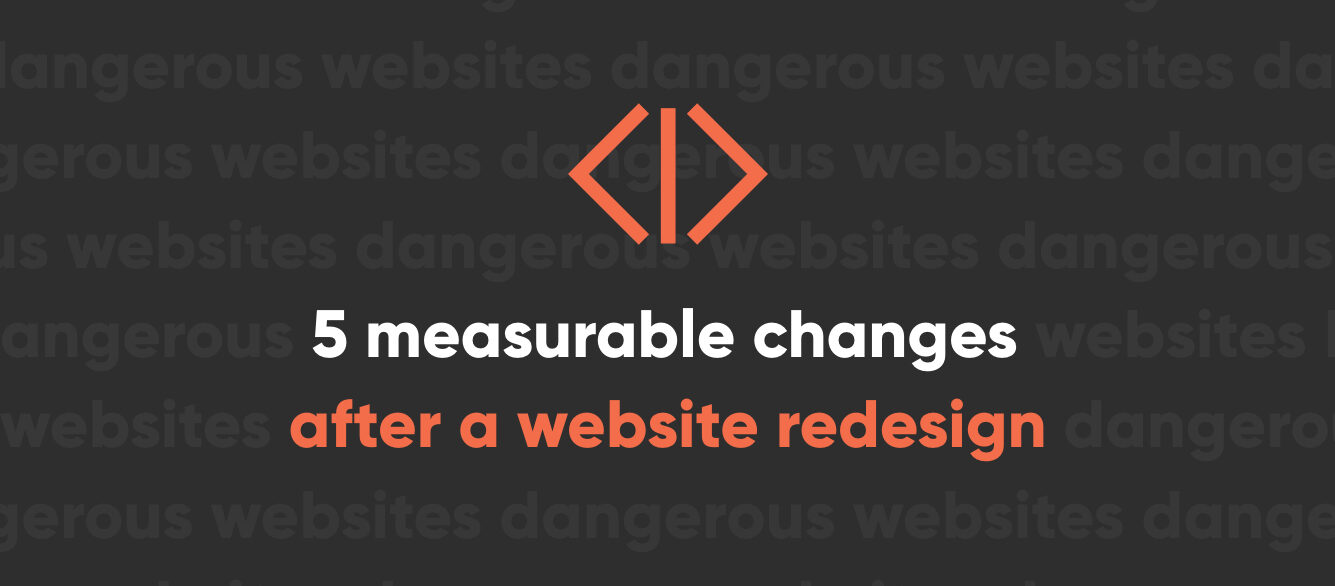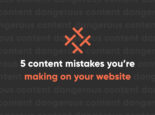
5 Measurable Changes After a Website Redesign

Almost every business owner knows there is value in having a great website, but many business owners are wary of the process. Redesigning a website is no easy task, and it can seem like a costly undertaking with little immediate reward. It’s difficult to understand the impact a new website can have on your business. This leaves many business owners skeptical that a website redesign is good for their business.
But worrying about the ROI of a new website isn’t just skepticism. It’s smart business. Why would you spend thousands of dollars on something that isn’t going to lead to positive results?
Measuring the Value of a New Website
If the web design process is done right, your business should see a positive return pretty quickly. While you probably won’t recoup the cost of the new website overnight or even within the first month, it’s not at all unusual for a new website to more than pay for itself within a year. Depending on your business model, you may see a positive return much sooner. And you will likely notice intangible benefits as soon as your website launches.
Since every business is different, it’s impossible to declare a universal timeline for the expected results of a new site. But no business owner should be satisfied with, "Well, your results may vary, but you should see something at some point."
That’s where your website analytics comes into play. From the day your new website launches, you can start measuring the positive impact of your redesign. In most cases, you’ll be wishing you had redesigned your website years ago.
Here are 5 measurable changes you can expect after your new website launches.
1. Higher Conversion Rate
One of the biggest reasons to redesign a website is because of low conversion rates. If you have a lot of visitors but not many customers, then this is a good sign that something is wrong with your site. A new website typically sees a much higher conversion rate. An experienced web designer knows what it takes to get customers to convert and can even use your past performance data to determine where the chokepoints were before. Website visitors are also much more likely to become customers when your website is trustworthy. And nothing is more trustworthy than a well-designed, modern website.
2. More Website Traffic
Your stale old website probably has been experiencing a plateau or even a decline in traffic. A new website is the perfect cure for several reasons. First, an updated website is more likely to rank well in search results. When your website sits for a long time without being updated, the search engines might start to view it as less relevant. So when your competitors launch their fancy new websites, they start to outperform you in search results. A new website doesn’t just generate more search traffic though. Your great new look makes for more shareable content. Your customers become more likely to refer their friends to you. You’re suddenly seeing more traffic from all channels. And since you are already enjoying a higher conversion rate, things are really starting to pay off.

3. More Leads and Sales
It should go without saying that a higher conversion rate and more traffic will result in more leads and sales. But conversion rate and traffic aren’t profit. The most important piece of data from your new website is your leads and sales. In some cases, leads and sales grow simply because the new site looks more trustworthy or works better on more devices. In other cases, your new site creates opportunities you were missing before. For example, adding the right contact form to your lead generation site might create hundreds of new leads you were simply missing on your old website. This is where the right design strategy can help maximize your ROI.

4. Lower Bounce Rate
Most website owners hate seeing bounces. We often view a high bounce rate as an immediate indicator that something is wrong with our site. While this isn’t always the case, a new website has a knack for reducing your bounce rate. In many cases, a good number of those bounces were due to outdated look, slow load time, poor functionality, or device incompatibility. Since these issues were all fixed with your new design, your bounce rate suddenly dropped. And the longer visitors stay on your website, the better the chance they’ll become customers.

5. More Return Visits
There are many reasons someone might return to your website. Maybe they want more information. Maybe they’ve decided to contact you or want directions to your business. Maybe they want to finish a purchase. In most cases, a return visit is a good thing for your website. Very few people come back to your website with the intention of doing nothing (unless your site is so bad that they’re coming back to with the sole purpose of laughing at you). A great web design is much more likely to bring people back. Your website is often the first point of contact a potential customer has with your business. If you set the right impression during that first visit, you just might land a lifelong customer.
Maximizing ROI with The Right Design Strategy
Of course, all this assumes there was a thoughtful strategy placed in your new website. If you paid a rock bottom price for a quick solution that barely meets the minimum requirements of today’s technology, then you shouldn’t expect to see any of these results. In fact, a new website that’s poorly done may result in a loss of business.
If you’re going to take shortcuts, you’d probably be better off keeping everything how it is. But if you want to take a big step towards reaching your business goals, a new website can often get you there faster than anything else.

Nate Tower
Nate Tower is the President of Perrill and has over 12 years of marketing and sales experience. During his career in digital marketing, Nate has demonstrated exceptional skills in strategic planning, creative ideation and execution. Nate's academic background includes a B.A. with a double major in English Language and Literature, Secondary Education, and a minor in Creative Writing from Washington University. He further expanded his expertise by completing the MBA Essentials program at Carlson Executive Education, University of Minnesota.
Nate holds multiple certifications from HubSpot and Google including Sales Hub Enterprise Implementation, Google Analytics for Power Users and Google Analytics 4. His unique blend of creative and analytical skills positions him as a leader in both the marketing and creative worlds. This, coupled with his passion for learning and educating, lends him the ability to make the complex accessible and the perplexing clear.



